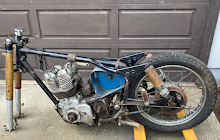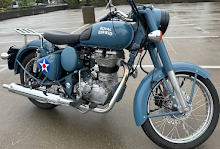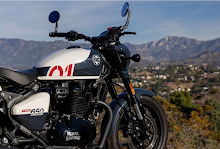
Dan Holmes is frank: "I felt I had an obligation to complete what we had started at Bonneville," he said. "People had contributed money. My health had improved -- and I had been literally sent home to die.
"They gave me a bi-ventricular / defibrillator / pacemaker. Fancy name for electronic ignition. I kept improving. Then Bob Hutchinson and Classic Motorcycle Association came along and he had the resources and enthusiasm to make it happen.
"As a result there is a pretty good likelihood we'll be back next year. It all boils down to financial considerations."
The 2008 results certainly surprised many who would never imagine that Royal Enfield motorcycles, designed in the 1940s, would be setting records at the Bonneville Salt Flats. But the three records, two for the road racing motorcycle and one for the semi-streamliner, left the team feeling there was more to gain.
"We had hopes and every reasonable expectation to set four records," Holmes said. Then (competitor) Cliff Gullett was killed (and activities ended for the day). We were literally on the starting line with the engine running when that happened. We got the horizontal motion to cut the engine and it was over for the day.
"We were assured that we would be first down the track Friday morning. But when we got through (the officials) there were 12 to 15 people in front of us. Nobody is going to give up their spot. Mark (Brownlee, rider of the semi-streamliner) had to start the engine and shut it down again. It was on the verge of overheating -- we were monitoring it. I made the decision to stop and get into tech inspection so we could preserve the records we'd already set.
"I really felt that I had satisfied my commitment to the world."
But it hadn't been a wasted effort. The time spent figuring out the right jetting for the Bonneville bike had enabled almost immediate success with the road racing bike. That was a huge accomplishment, under the circumstances.
"People don't realize what it's like out there on that salt. It's HOSTILE. Like being on the moon. The first time I was out there it was just so hot and humid that I wasn't necessarily that anxious to go back.
"And that salt, when it gets wet, it is so corrosive it destroys stuff after the fact. You have to clean, polish, lubricate, oil and reassemble everything. That makes it a pretty big job. After the first time out there, you find out the hard way, six months later, when stuff is really deteriorating. It's like cancer."
How did Holmes and his team end up on the Bonneville Salt Flats trying to make Royal Enfield thumpers go fast?
"I grew up in the motorcycle business. I never really set out to be a legend. I was just interested in being a motorcycle dealer again. My dad had the Honda shop. I had Dan's repair shop. The chance to be a Royal Enfield dealer just came along at the right time. What was really miraculous was the place my shop was at, you would have said no way were they going to allow me to have a motorcycle dealership in there. It was just meant to be."
Holmes' DRS dealership in Goshen, Ind., was the pacesetting Royal Enfield dealership in the United States until ill-health forced him to close. The DRS "shift kit" became the standard aftermarket upgrade for the balky left-side shift required on four-speed Bullets imported to the U.S.
"I was the first dealer to have an inventory of parts. I had to explain what (a dealership) was! Being in the Honda business, those were dictated terms. You're going to buy those parts with the dealership. It finally worked out that (the Enfield parts distributor) would send me one of everything he had two of! I'd had to ask him how I was going to be a dealer and repair these things if I didn't have any parts.
"Eventually I had probably the largest inventory of Royal Enfield parts of any dealer in the U.S. I'm sure that Kevin Mahoney and Classic Motorworks have gone far beyond that now that he has taken over the parts."
He's concerned about getting credit for Bonneville to his team. Engine builder Glenn Kyle, for instance, whose major contribution Holmes stresses because Kyle "is just extraordinarily modest.
"I shoot straight," Holmes said. "I grew up in a race shop. Our policy was 'don't tell 'em -- show 'em.' And Kevin, for one, has said he has learned to recognize that I'm 'the real deal.'"
Dan let others take the lead in publicizing this year's successes at Bonneville. CMA has an active website and Mahoney put daily updates of results on his Classic Motorworks' web site. Dan was content "to let results speak for themselves."
"I do have a chat group on Yahoo, Royal Enfield Speed Record. Phil (Myers) and I put some stuff up on that." He is considering putting together a book of photos with his commentary but isn't sure sales would cover the cost.
Besides, "I'm not conceited or anything. Team DRS is my focus."
What about his health?
"(The pacemaker) paces my heart 99 percent of the time, will shock me back to life if irregular and triggers my left ventricle to contract early to rebound the hydraulic action of the right. More or less increases my oil pressure and keeps it all in time.
"My Ejection Fraction is 15 percent. Normal people are 60-65 and athletes are 70. This has to do with 100cc in and 70cc out. In my case they have a graph that at 30 percent, you have three to five years to live statistically and 50 percent do not make it. The electronic ignition is a miracle. With the pacemaker I mimic a healthier heart and it gives me a 25 percent Ejection Fraction. While this is not stellar it sure is better than 15. I hope to get along for another 10 years with my heart and then subscribe to the inevitable heart transplant!"
"They gave me a bi-ventricular / defibrillator / pacemaker. Fancy name for electronic ignition. I kept improving. Then Bob Hutchinson and Classic Motorcycle Association came along and he had the resources and enthusiasm to make it happen.
"As a result there is a pretty good likelihood we'll be back next year. It all boils down to financial considerations."
The 2008 results certainly surprised many who would never imagine that Royal Enfield motorcycles, designed in the 1940s, would be setting records at the Bonneville Salt Flats. But the three records, two for the road racing motorcycle and one for the semi-streamliner, left the team feeling there was more to gain.
"We had hopes and every reasonable expectation to set four records," Holmes said. Then (competitor) Cliff Gullett was killed (and activities ended for the day). We were literally on the starting line with the engine running when that happened. We got the horizontal motion to cut the engine and it was over for the day.
"We were assured that we would be first down the track Friday morning. But when we got through (the officials) there were 12 to 15 people in front of us. Nobody is going to give up their spot. Mark (Brownlee, rider of the semi-streamliner) had to start the engine and shut it down again. It was on the verge of overheating -- we were monitoring it. I made the decision to stop and get into tech inspection so we could preserve the records we'd already set.
"I really felt that I had satisfied my commitment to the world."
But it hadn't been a wasted effort. The time spent figuring out the right jetting for the Bonneville bike had enabled almost immediate success with the road racing bike. That was a huge accomplishment, under the circumstances.
"People don't realize what it's like out there on that salt. It's HOSTILE. Like being on the moon. The first time I was out there it was just so hot and humid that I wasn't necessarily that anxious to go back.
"And that salt, when it gets wet, it is so corrosive it destroys stuff after the fact. You have to clean, polish, lubricate, oil and reassemble everything. That makes it a pretty big job. After the first time out there, you find out the hard way, six months later, when stuff is really deteriorating. It's like cancer."
How did Holmes and his team end up on the Bonneville Salt Flats trying to make Royal Enfield thumpers go fast?
"I grew up in the motorcycle business. I never really set out to be a legend. I was just interested in being a motorcycle dealer again. My dad had the Honda shop. I had Dan's repair shop. The chance to be a Royal Enfield dealer just came along at the right time. What was really miraculous was the place my shop was at, you would have said no way were they going to allow me to have a motorcycle dealership in there. It was just meant to be."
Holmes' DRS dealership in Goshen, Ind., was the pacesetting Royal Enfield dealership in the United States until ill-health forced him to close. The DRS "shift kit" became the standard aftermarket upgrade for the balky left-side shift required on four-speed Bullets imported to the U.S.
"I was the first dealer to have an inventory of parts. I had to explain what (a dealership) was! Being in the Honda business, those were dictated terms. You're going to buy those parts with the dealership. It finally worked out that (the Enfield parts distributor) would send me one of everything he had two of! I'd had to ask him how I was going to be a dealer and repair these things if I didn't have any parts.
"Eventually I had probably the largest inventory of Royal Enfield parts of any dealer in the U.S. I'm sure that Kevin Mahoney and Classic Motorworks have gone far beyond that now that he has taken over the parts."
He's concerned about getting credit for Bonneville to his team. Engine builder Glenn Kyle, for instance, whose major contribution Holmes stresses because Kyle "is just extraordinarily modest.
"I shoot straight," Holmes said. "I grew up in a race shop. Our policy was 'don't tell 'em -- show 'em.' And Kevin, for one, has said he has learned to recognize that I'm 'the real deal.'"
Dan let others take the lead in publicizing this year's successes at Bonneville. CMA has an active website and Mahoney put daily updates of results on his Classic Motorworks' web site. Dan was content "to let results speak for themselves."
"I do have a chat group on Yahoo, Royal Enfield Speed Record. Phil (Myers) and I put some stuff up on that." He is considering putting together a book of photos with his commentary but isn't sure sales would cover the cost.
Besides, "I'm not conceited or anything. Team DRS is my focus."
What about his health?
"(The pacemaker) paces my heart 99 percent of the time, will shock me back to life if irregular and triggers my left ventricle to contract early to rebound the hydraulic action of the right. More or less increases my oil pressure and keeps it all in time.
"My Ejection Fraction is 15 percent. Normal people are 60-65 and athletes are 70. This has to do with 100cc in and 70cc out. In my case they have a graph that at 30 percent, you have three to five years to live statistically and 50 percent do not make it. The electronic ignition is a miracle. With the pacemaker I mimic a healthier heart and it gives me a 25 percent Ejection Fraction. While this is not stellar it sure is better than 15. I hope to get along for another 10 years with my heart and then subscribe to the inevitable heart transplant!"

























No comments:
Post a Comment